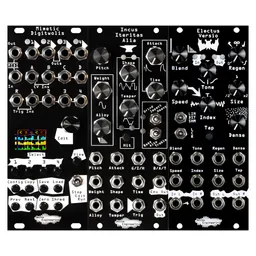It’s time for another addition to our Getting Started in Eurorack series, and today we’ll be discussing inputs and outputs. Inputs and outputs are important utilities that can help your Eurorack system connect to the outside world. Today, we’ll talk about their general features, when you might need to use them, and how to connect your system to other gear.
Do I need an output module?
Output modules are a Eurorack utility that take Eurorack signals and convert them to another format, and sometimes change their level. Features vary from module to module, but the most common type takes a stereo input from your case and converts it to another format. In many cases, you may not actually need an output module. If you’re simply recording your case into an audio interface or a portable recorder, or if you are patching your modules directly into a mixer, you may just need some ⅛” to ¼” adapter cables. Eurorack levels tend to be relatively high, but a lot of pro-audio gear can take it as an input without issue. If your audio is clipping, you can run it through an attenuator to bring the level down.
Output modules can be useful for a variety of situations, however. For instance, if you’d like to connect your Eurorack system directly to PA at a performance, having balanced outputs on ¼” or XLR jacks is the best way to do so. There are also studio situations where an output module can be helpful: if you’d like to connect your system to a pair of studio monitors, having a volume control as well as balanced outs will allow you to do so and keep your levels where they should be. If your case is far away from your recording interface or mixer, using balanced cables can help eliminate noise. And if you’re using a high-end mixer or interface with DB25 inputs, there are a number of output modules that can connect to them directly.

How do I use headphones with Eurorack?
If you’d like to use headphones with your system, a dedicated output module is the only in-the-case solution: headphones use dedicated circuitry, and patching them directly to a regular module could damage your headphones. More importantly, Eurorack modules output at levels that should be attenuated before you listen to them. Failing to do that can damage your hearing, and we don’t want that.
Personally, I enjoy having headphone outputs on all my systems: it’s always nice to be able to monitor late at night without bothering the neighbors.
Do I need an input module?
Eurorack signals are generally much louder than signals used by other audio equipment. Input modules range from simple to complex, but the core concept is the same across all of them: they take an external signal, amplify it to Eurorack levels, and output it on an ⅛” jack. Some input modules only work with synthesizers, others have different settings for using things like guitars and other instruments with pickups, and some even work with microphones. If you want to get a sound into your Eurorack system, you can probably do it: just make sure that your input module has the features you need.
Most input modules feature gain controls to change the level of incoming signals. Some have extra features like envelope followers or gate extractors which create patchable signals based on incoming signals which can be a lot of fun and can open up options for creating patches related to the sound you’re sending into your system. If you are purchasing an input module, think through your expected use cases for it, and find one that suits your needs.
Do I need a module for patching effects pedals?
Some users like using effects pedals with their systems, and modules exist that are designed to integrate seamlessly with external effects. They provide both inputs and outputs at levels suitable for pedals. This can be especially useful in smaller systems where effects units may take up too much HP, or when there isn’t a Eurorack alternative to a particular pedal.
Suggested modules:
Strymon AA.1: A simple stereo pedal loop.
Joranalogue Receive 2: A pair of inputs that can be used with XLR or ¼” connectors.
Sono Abitus: A stereo output module that has both balanced ¼” outputs and a headphone






